Download the user manualUser's guide for "Antiplagiat" system
- Introduction
- Preparation for the start
- Profile
- Customer Care Service
- Adding a website
- Workspace
- The report on the text reuse check result
- Purchase of services in the workspace
- Contact information
Introduction
This manual is intended to familiarize you with the means of work in the "Antiplagiat" .
The manual contains information about the purpose, capabilities, features of the system, as well as a description of the actions that provide check of text documents for the detecting reuse.
Terms and definitions
|
Term |
Definition |
|---|---|
|
System "Antiplagiat" (service) |
Online tool for working with text documents with user interface on the web-site. |
|
Text similarity |
A fragment of the document text that contains the text or a fragment of the source text and is not formatted in accordance with quotation rules |
|
Text recycling |
A fragment of the document text that contains the text or a fragment of the source text, the author or co-author of which is the author of the checked document |
|
Quotes |
A fragment of the document text that contains the text or a fragment of the source text and formatted in accordance with the rules of quotation, with full bibliographic information about the source. Also quotes include common expressions, bibliography, fragments of text found in sources from the collections of regulatory documents. |
|
Text similarity percentage |
The proportion of all found similar text in relation to the total size of the checked document in characters |
|
Text recycling percentage |
The proportion of all found text recyclings in relation to the total size of the checked document in characters |
|
Quotes percentage |
The proportion of all found quotes in relation to the total size of the checked document in characters |
|
Originality percentage |
The proportion of all document text fragments that were not found in the sources used for check, in relation to the total size of the checked document in characters |
|
Report |
The result of checking the text for reuse:
|
|
Report share |
The ratio of the volume of matches that is taken into account within this source to the total volume of the document. That is, if the same text was found in several sources, it is taken into account only in one of them. When summing up the shares in the reports for all sources, a percentage of "Similarity" is obtained. |
|
Text share |
The ratio of the volume of matches of the source text to the volume of the document. The shares in the text by sources are not summed up when calculating the total percentage of matches. |
|
Report blocks |
The number of text similarity blocks from the source, taking into account the intersections of all found sources. |
|
Text blocks |
The number of text similarity blocks from a source without regard to other found sources. |
|
Collection (search module) |
The software module of the corporate version of the system "Antiplagiat", implementing the search for text reuse. The module uses a search index or a special computational algorithm to build reports. The system can have several collection. Search modules may differ in purpose, for example:
Once you have access to several search collections, you can build both individual reports and a single report for all search collections. Some collections perform searches across specialized databases with the casts of the texts of the source documents, but to obtain access to the selected search module doesn't mean getting access to the full texts of the documents it can find this collection. In the received reports, links to the documents will be indicated (their names will also be given), and when viewing the source text, it will contain fragments that coincide with the document being checked. |
|
Browser |
Software that allows users to view pages on Internet sites and access files and software associated with those pages. For example, Mozilla Firefox, Google Chrome, etc. |
|
Text metrics |
Semantic characteristics for each uploaded document. |
Purpose and conditions of use
The service is designed to check text documents for plagiarism. As a result of the scan, users receive text reuse reports. The report contains information on the sources and indicators of text similar to source, as well as detailed information with the indication of those fragments of the checked document that have been identified as text similarity. The identification is accompanied by the presentation of the matching text fragment of the borrowing source and/or the reference to the original (URL). As a result of the document check, the user can determine which part of the document is written independently and which part is reused.
To use the service you need:
- Connect to the Internet;
- Install a browser or use the browser of one of the most common types built into your operating system (MS Edge version 97 and above, Mozilla Firefox version 90 and above, Opera version 78 and above, Chrome version 92 and above).
The results of work with the system "Antiplagiat" are not the basis for claims of copyright violations, the service is aimed at use only for information purposes. In other words, we do not declare that a particular text is plagiarism, but only inform you about the presence of the same or similar text fragment. It is possible that when working with the service, you will find the text copied from other sources, including the possibility that the downloaded document is the original source. In any case, when working with the service, be careful, try to be objective and do not rush to conclusions. Remember that the service is only a tool of work, and only the user can give a real assessment to the document.
Preparation for the start
Workplace
To prepare the workplace when working with the system "Antiplagiat" it is enough to open a browser. To work with the service, browsers of the most common types, such as MS Edge version 97 and above, Mozilla Firefox version 90 and above, Opera version 78 and above, Chrome version 92 and above, can be used.
To get started, go to the service website by typing in the address bar of the browser address you received by e-mail from the administrator of the company.
So, we have a ready workplace:
- files downloaded to your computer;
- the browser is open;
- the service's website page is opened in the browser.
User registration
Before the beginning of the work, the user must be authenticated on the site. If you are already registered on the site, you should log in. Learn more about logging into the system from the section Log in and out of in the system.
To register on the site, open the registration window by clicking on the "Sign up" button on the main page of the site.

In the window that opens, enter your email address and click "Sign up".
Before completing the registration, you will be asked to review the terms and conditions, which contain user agreement and the agreement for the processing of personal data. To accept the user agreement, flag the box next to "I agree to the terms ...". Pressing the "Sign up" button means that you have read and accept the terms of the user agreement and agreement for processing personal data. You can view the documents in a separate window by clicking the “terms and conditions” link.
To continue registration in the system, enter your e-mail address and click on the "Register" button.

After a while, an email will be sent to the specified e-mail address with a link to the password setting page. Follow this link.
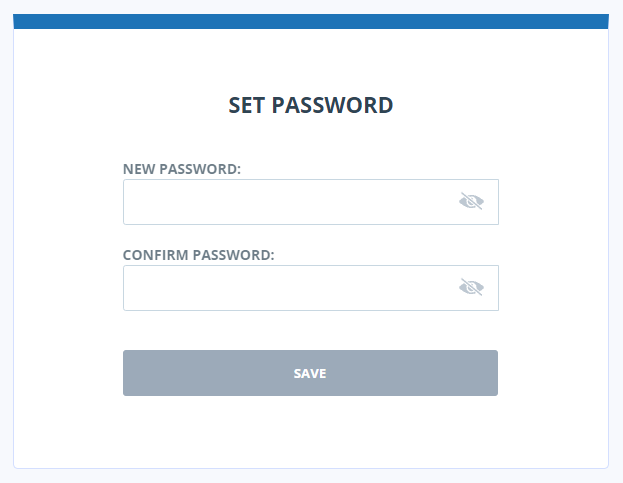
On the opened page, enter the password and its confirmation. The "Save" button becomes active if the entered password meets the security requirements and the passwords in the "New password" and "Confirm password" fields match. You can first make sure that the password was entered correctly by clicking on the visibility button on the right side of the corresponding field. Then, symbols are displayed instead of dots.
- At least 8 characters.
- Maximum 16 characters.
- At least 1 capital Latin letter.
- At least 1 digit.
To save the password in the system, click on the "Save" button. After saving your password, you will be automatically logged in and redirected to your Workplace.
If the password was successfully saved in the system, then the link to the password setting page becomes invalid. Use the user profile to change the password. Learn more about changing your password in the Change password section.
If your mail has already been used for registration before, you will not be able to register with this mail again. In this case, to access the Workspace you need to use the “Log in” button.
If the letter does not come to the email box for a long time, try the procedure again. Make sure that the mail is entered correctly.
Login and logout from the system
If you are a registered user, use the login form to access the system, click on the "Log in" button in the upper right corner of the page.
Enter your credentials in the login form. Click on the "Show password" button if you want to check the correctness of the password. Click "Log in".
If you have forgotten your password, use the "Restore password" link. For more information about password recovery, see Рassword Recovery.
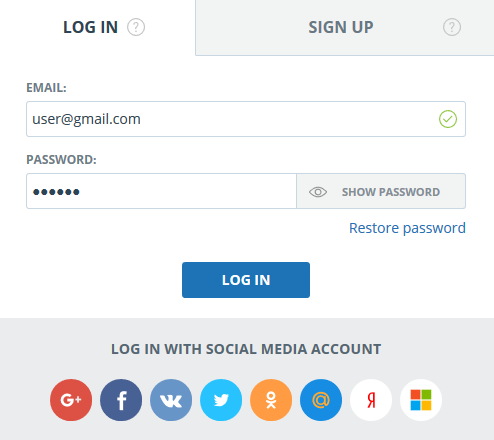
After authorization, the menu icon is displayed on any page of the site in the upper right corner of the page. When you click on the icon, the navigation through the sections of your account will be available. To the left of the "Menu" icon you may see a brief information about yourself: the role in the system and e-mail.
To log out, click on the "Menu" icon and then select "Log out".
You can use social networks to enter the workspace. More details in the next paragraph.
Social media accounts
When you sign up or log in to your personal account, you can link to your social media accounts. Link to the social network allows you to quickly log in to your personal account using your social network credentials.
To link the account to a social network, open any window - "Login" or "Sign up" and select the icon with the social network you want to attach.

A special window will open to confirm the data transfer from the social network. If you have not yet introduced yourself to the social network site, you will be prompted to log in in this window.
The social network site will ask you for confirmation to send your credentials. Confirm the sending of the data.
After that, you will be redirected back to the registration completion form, using the form you can choose: attach a social media account to an existing account on the site or register a new account with the social media account.
If you selected "I am a new user", the registration window will open, fill it in and click "Create account". You will be sent, enter the password and click "Create account" again to complete the registration.
After completing the registration you will be able to log in using the attached account.

If the entered mail is the same as the mail of your account or was automatically entered using the data received from the social network, then you will not need to enter the password – you will be logged in immediately after clicking "Create account". To the indicated e-mail will be sent a password, with this mail and password. In case of failure of the social network site you can enter the Workspace the standard way.
If you have already received mail from the social network, you can attach a social network account to your existing account of the "Antiplagiat" system.
If you selected "I already have a username", then log in using your credentials, with which the registration was made.
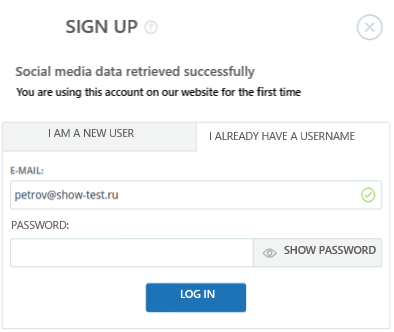
After logging in, the social network account will be linked to your account on the Antiplagiat website.
Please note that if you change e-mail in the social network, you should change it on the Antiplagiat site for successful login.
Password restore
If you cannot access your personal account because you have forgotten your password, you can perform the password recovery procedure.
To recover your password, click on the "Restore password" button in the login window. In the window that opens, enter your email and click " Restore".
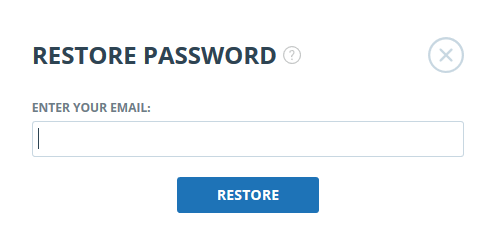
An email will be sent to the specified email address with a link to the password setting page. Follow the link and set a new password. The process of setting a password is described in more detail in the section User registration. Use your e-mail and the set password for authorization during further work.
Profile
To go to your profile, click on the "Menu" icon in the upper right corner and select "Profile".
Profile is a special section of the Workspace, where you can view and edit the credentials and additional data of your account.
You can specify your personal data and upload an image in your profile. To do this, enter your data in the fields and click "Edit". To upload an image to your profile, click on "Upload image". To return to the default image, delete the uploaded image in your profile by clicking on "Delete".
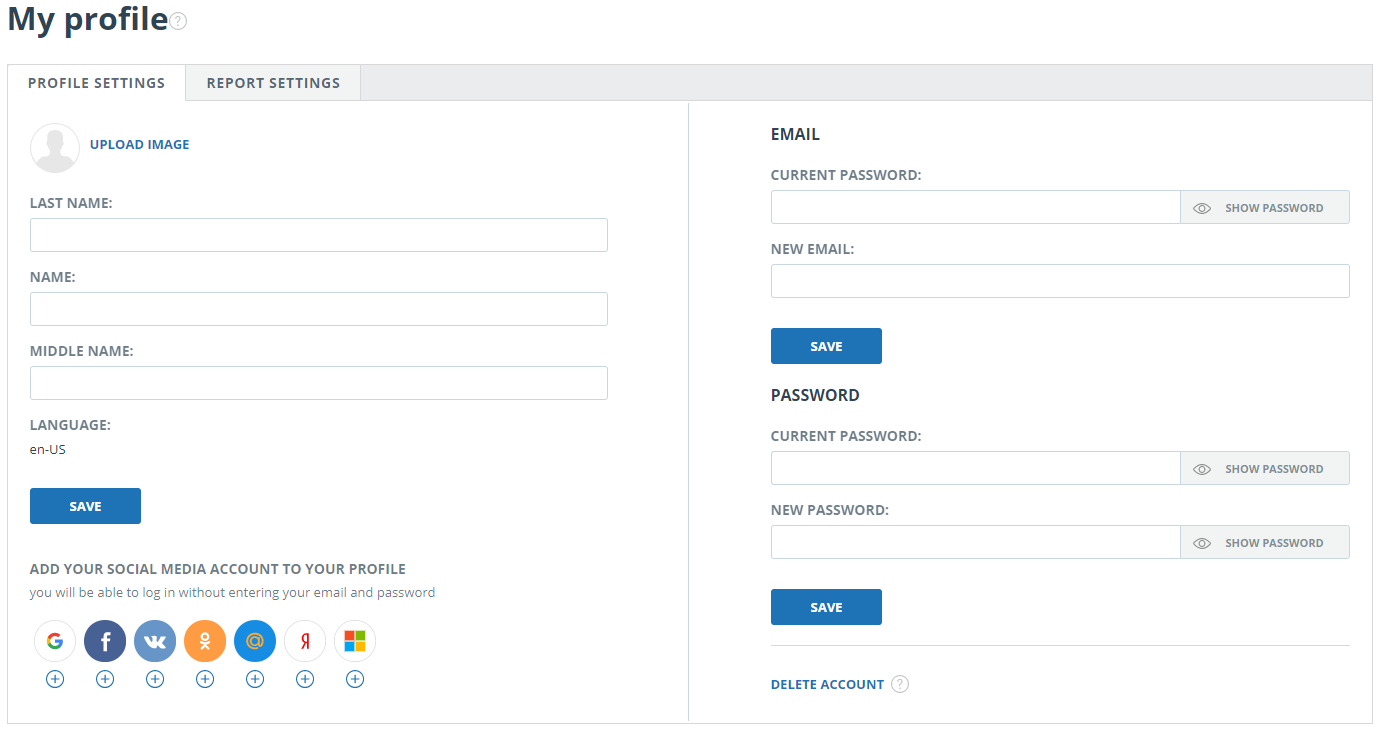
Email change
In order to change the e-mail that is used to log in, enter your current password and your new e-mail address and click "Save".
When the button is clicked, the site will show the message: "a link to confirm the change of mail has been sent to the new mail".
Go to your mailbox, the address of which you have specified as a new email, and then click on the link in the email .

Thus, by clicking on the link, you confirm that you have access to the specified mail. Immediately after clicking the link to check the changes your new email to be completed.
Password change
To change your password, you will need to enter your old password and then enter your new password in the appropriate fields. The new password must meet the requirements.
You can make sure that the password is entered correctly by clicking on the "Show password" button. After that, you will see symbols instead of dots.
If you are sure that you have entered the password correctly, click on the "Save" button, and your password for access to the Antiplagiat service Workspace will be changed to a new one.
To save the new password in the system, click on the "Change" button. Use your e-mail and new password for authorization during further work.
Link with the social media account
If you want to login to the system without entering e-mail and password, it is necessary to link your social media accounts with your profile. To link to a social network, just click on the "+" (plus) sign or the icon of the social network you want to attach. After clicking the social network window opens with a confirmation form to send data, you need to confirm your consent to link to a social network.
If you have not yet been logged in to the social network, the social network will require you to log in before confirming the data submission.
Immediately after receiving your consent from the social network sent the data necessary to log in to the workspace, now when you log in, you can use the icon "Log in using the social network."
On the Profile page, you can also perform the reverse action - detach the social network account by clicking on the "X" icon located under the icon of the attached social network, or on the icon itself.
You can only link one account from one social network, so if you want to link to the same social network, you must first unsubscribe and then create the new link.
Delete your account
To delete your account, you should click on the "Delete account" button. After that, the account deletion page will open.
Please note that you can't restore access to deleted account! Your balance points, documents and reports will be deleted permanatly!
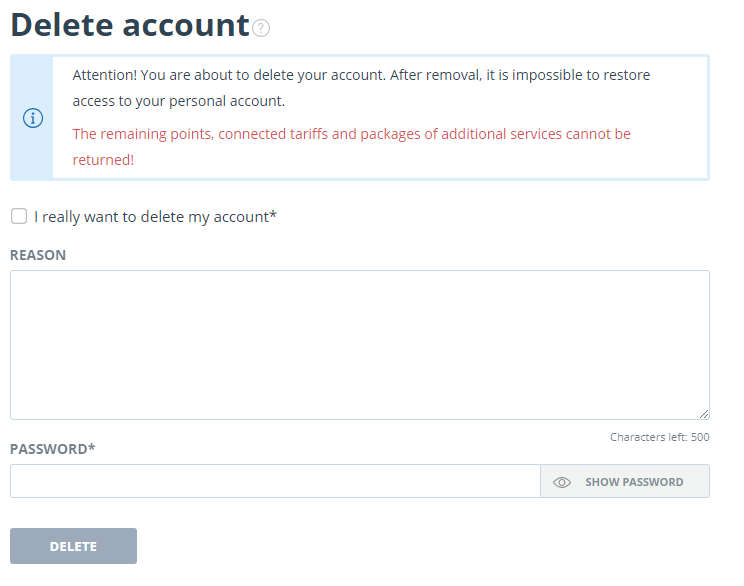
To confirm your actions, set the checkbox near the text "I really want to delete my account". After that, enter the password and optionally inform the reason of the account deletion. After clicking on the “Delete Account” button, your account will be deleted permanently.
Customer Care Service
If you do not find answers to questions about the system, please contact Customer Care Service. To do this, click on the "Menu" in the upper right corner and select the "Customer Care Service" tab. The system opens a window with a form to send the case.

Enter your question in the "Message" field and click on the "Send" button. Our experts will respond to your request to the e-mail, which was used to log in.
Adding a website
Our Internet search module performs a check on the already indexed sites of the web. If you find an interesting site or resource that is not included in the Internet search module, you can add it to our search module. This will allow you to build more complete and reliable reports for check through the Internet search module.
To add a website for indexing, click on "Menu" and select "Add website". Copy the link in the URL field and click "Add". You can also leave a comment about the site to which this link leads, for example, that this site is an open e-library or abstracts site.

If the site you specify is already known to our system, you will receive the message: "The Site has already been processed by our system".
Please note that the new website will be placed in the Internet search Module according to the order of the indexing queue.
Workspace
The Workspace provides an opportunity to upload and check documents. To access the document check, click on the «Menu» and select the «Workspace» section.
Use the «Enter the Cabinet» button next to the «Menu» to go to the cabinet from any page of the system.

On the Workspace page, you will see the «Folders» and «Documents» panels, which are used to perform all the basic actions with the folders and documents of the Workspace.
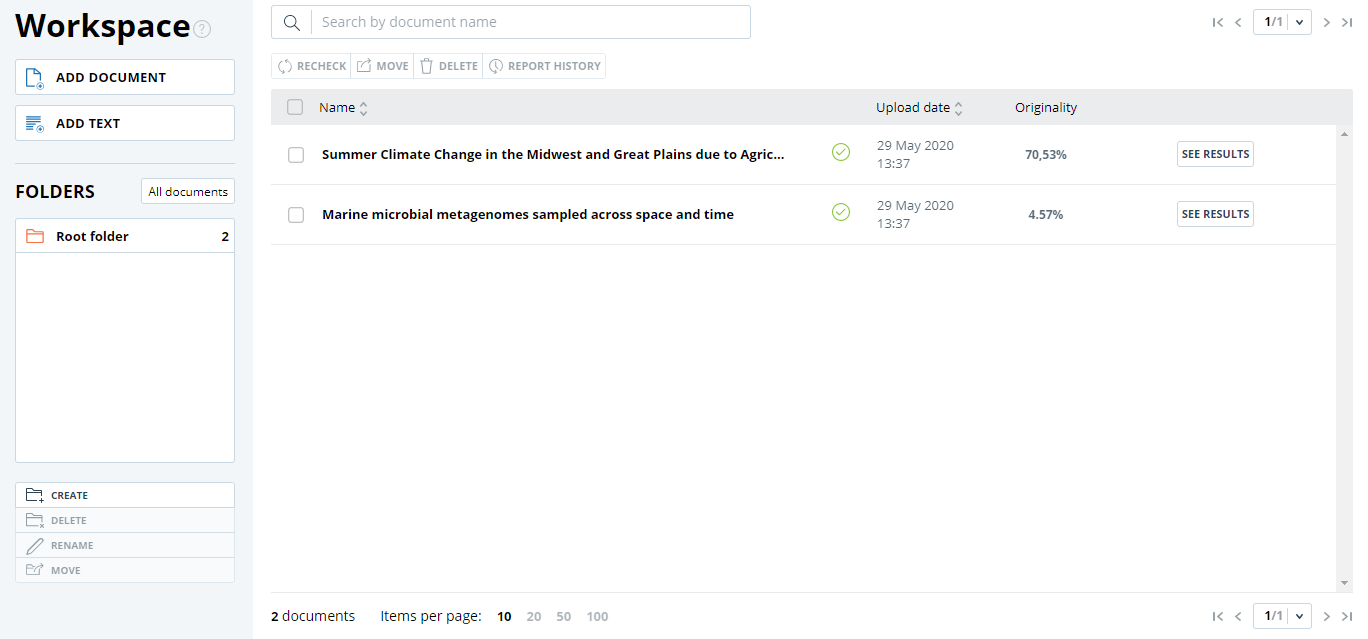
Document upload
To get started, click the «Check » button. If you have unused checks for Full L and/or Full XL tariffs, a modal window for tariff selection will appear. Select the required tariff and click «Continue». Then select the files on your computer or drag and drop the documents you want to the «Upload documents» field.
Please note that the «Check document» button in the upper right corner of the screen under the counter for the number of available checks allows you to get to documents upload from any page of the Antiplagiat system.

The counter on the right above the list shows the number of files selected for upload and the number of available checks within the selected tariff. To submit documents for checking, click the «Check» button.
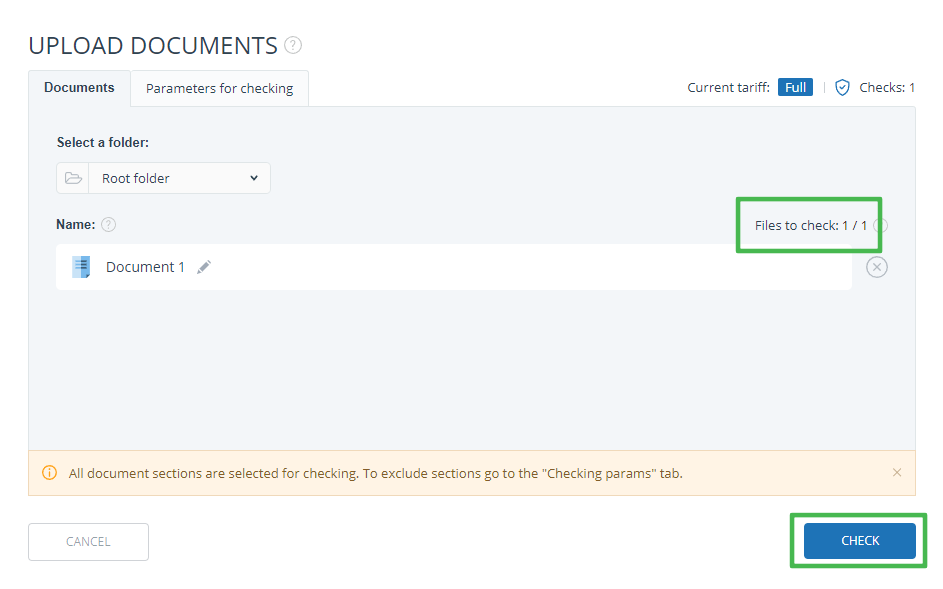
If the number of checks is not enough to check all selected documents, the counter will display the discrepancy in the number in red, and the «Check» button will be inactive. You can exclude files from the upload list by clicking on the icon to the right of the file to be excluded, or go to the checks purchase page by clicking on the «Buy checks» button in the message below.
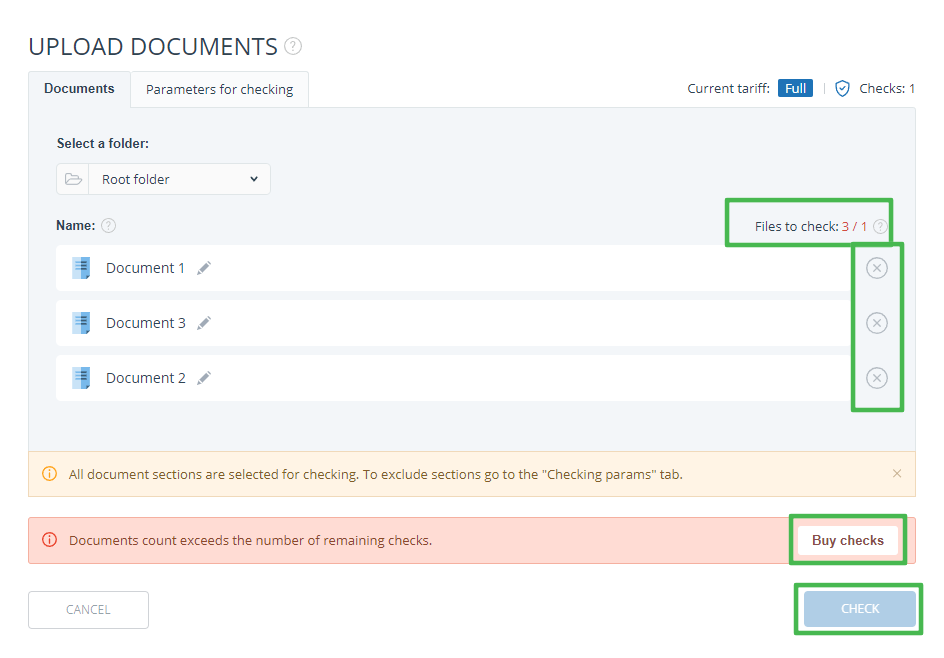
Please note that system has a limit for the number of symbols in one document. Documents which contain more than 2 million symbols are not checking. After uploading such documents error message will be displayed in Workspace.
Please note that at free rate plan you can upload only in PDF (with a text layer) and TXT formats. The size of the uploaded file should not exceed 15 MB. When you activate paid rate plan you will be able to upload the documents in formats: txt, html, htm, docx, doc, rtf, odt, pptx, pdf (including file without a text layer, OCR activation required), additional document check parameters described below will become available to you, and the maximum size of the uploaded file will increase to 20 MB.
Note: A text layer in a PDF is directly text data from a file that can be selected and transferred to another area for further processing as a set of characters, not as an image. A text layer in a PDF can be placed on top of other layers of the file, for example, on top of images. Please note that scans, photos and other images that depict printed characters are not a text layer. To check files containing images with printed characters, but not containing a text layer, you need to enable the Text Recognition (OCR) service
In addition to uploading individual files, it is possible to upload the archive in the format RAR, ZIP or 7z. In this case, all documents from the archive are processed separately.
Please note that it is prohibited to use ;<>=+&%#@[]{}~`®*\ symbols in the name of the document.
If you do not enter the parameters, the following default values will be applied to the document: the folder that was opened when viewing the user's Workspace is selected, the document type is not specified, the name is the file name, all possible check options will be set for the search modules (depending on the services connected by the company).
Document check
After adding files to the list you can specify save and check options of the document and choose the modules which should be checked against the document on the "Parameters for checking" tab.
Documents are checked taking into account the structure, you can include only the sections you need in the check. To exclude a section from the check, uncheck the box next to this section. Detailed information on each section will be available on the "Check Results" page in the "Document Structure" tab.
OCR - optical character recognition. The service allows you to check the text that is visible when viewing the document, but which is not a text layer (such text cannot be selected with the mouse). If the document contains graphic images with text data, they will be recognized and checked for originality.
Please note that when checking with OCR, the processing time of the document may increase. With OCR only the first 150 pages of the document are checked. The remaining pages will not be processed.

Next, click on the "Check" button, the document will be added to the Workspace and sent for check. In the folder where the document was added, you will see the added document, in the line with the document will be the date of loading the document. After the check is complete, the check results appear in the row.
Text check
In some cases, it is more convenient and faster to use the text check function, click on the "Add text" button. In the form that opens, type or paste in the text field, select the collections that will be used to check the document, and then click "Check".
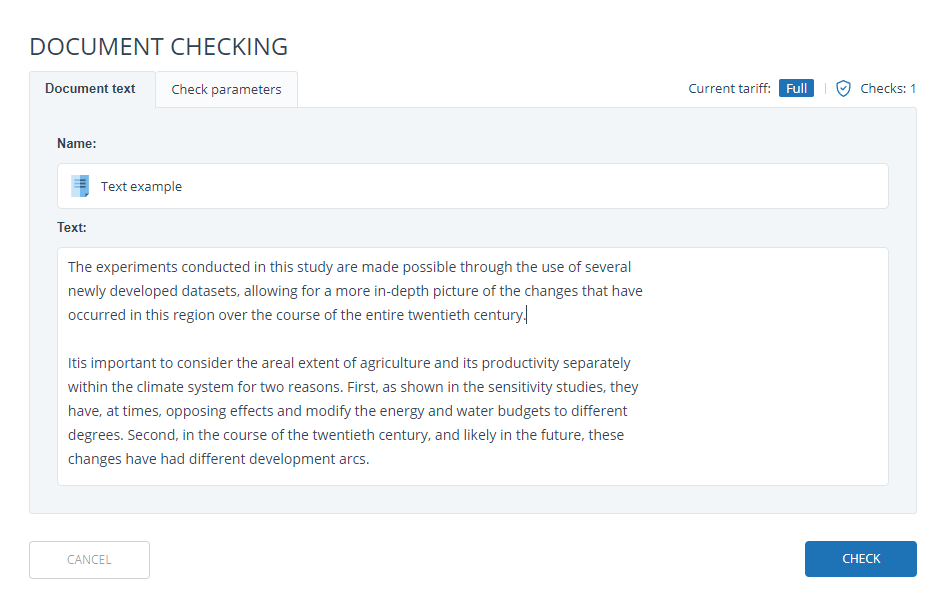
After you click "Check", a document will appear in your workspace, its name will be the same as the first word in the entered text (no more than 15 characters), and then a check for this document will start.
Document recheck
If you want to check an uploaded document through other collections, you can use the recheck option. Mark the selected document, then click on the "Recheck" button in the top menu.

In the dialogue window, select the search collections and click "Check".

We recommend that you do not perform repeated checks on the same collections as in the previous checks: most likely, the result in this case will be identical.
The document will be sent for check and after a while the results will appear in the line with the document. It is impossible to send the document for rechecking, if it is in the process of checking.
Viewing and editing document information
Each document when added or moved to the Workspace is placed in the folder of the Workspace. Once you click on the name of the folder in which there are documents, you will see the documents contained in the respective folder.
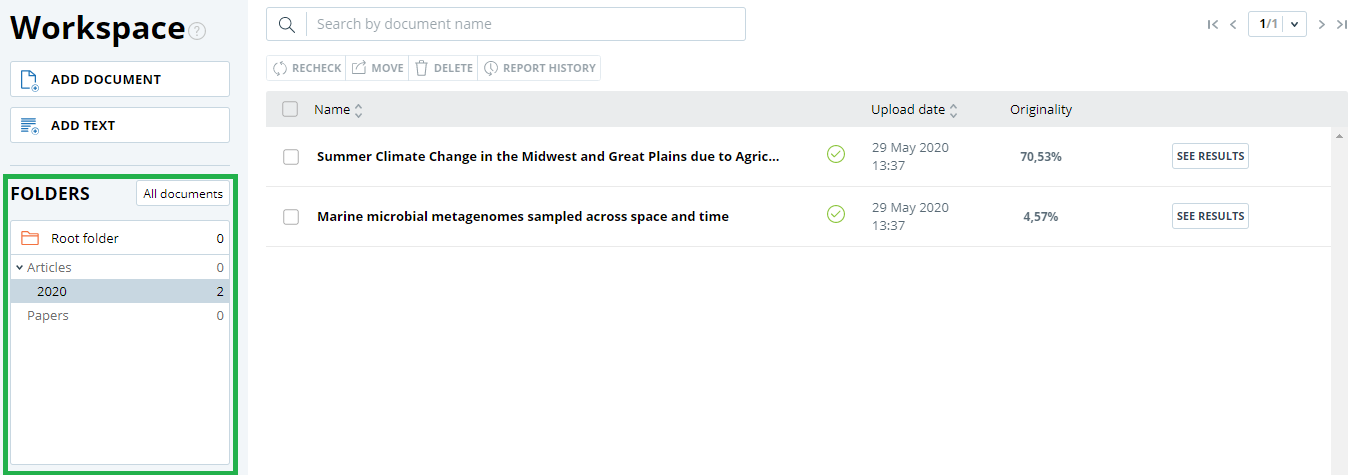
Documents are arranged in a list. Each row in the list displays information about the document, the result of the check, and a link to the report.
The originality assessment in the document line is intended for the primary, superficial acquaintance with the results of the check. To get a detailed assessment of the results of the test, go to the scan report view by clicking on the "See results" button. After that select "Full Report".
To view the information about the document, open the folder, click the "See results" button located next to the document. After that select "Document statistic". A window will open with the document attributes and information about the date and duration of the upload.

To view the text of the uploaded document, click its name in the list of documents. The "Version for reading" page opens, displaying the text of the document in page-by mode.
To navigate through the text pages, use the paging panel located above and below the text box. You can display all pages of the document at once by clicking the "Show all pages" button under the text field.
On the tabs "Initial view" and "Annotation" you can see the text of the loaded document with the original formatting and annotation to the document, respectively. An annotation to the document is automatically generated by the system and consists of several sentences from the document to get an idea of its content.
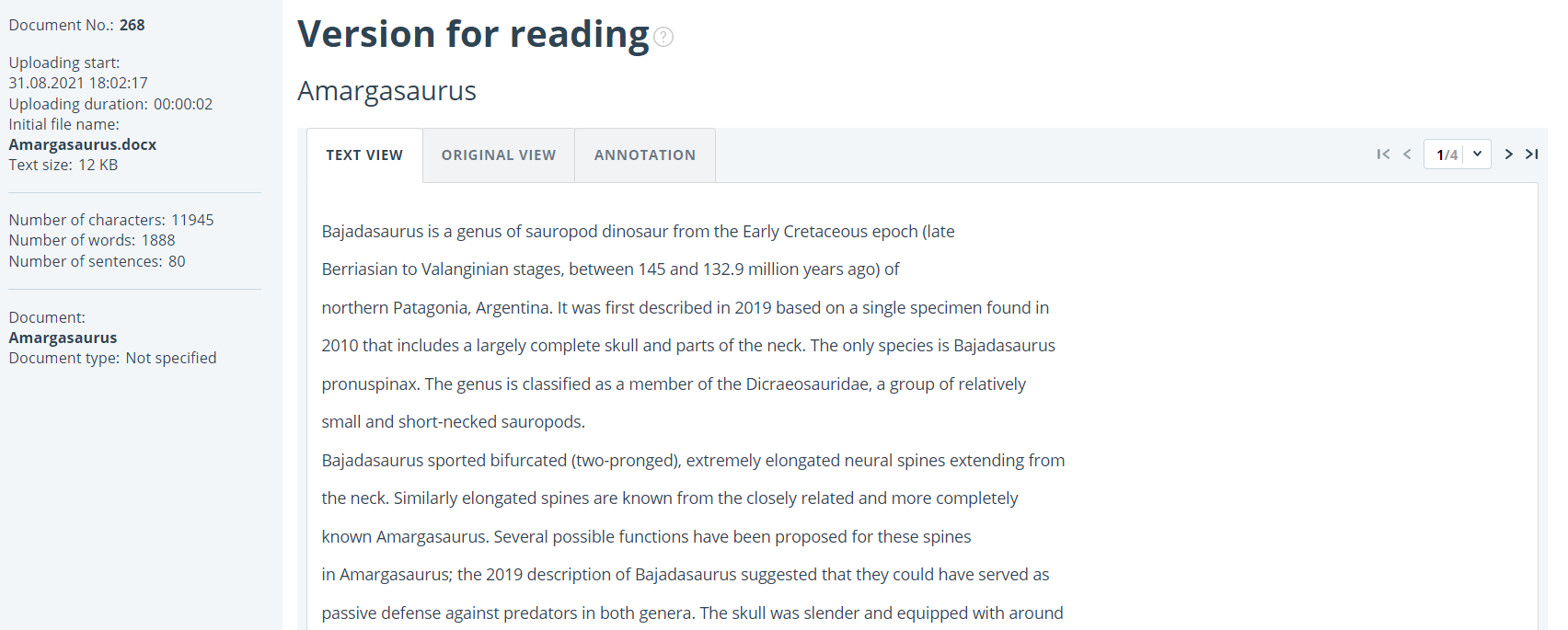
The same operation can be performed by selecting the desired document in the Workspace and clicking the "Change name and type" button in the top menu. In the window that opens, you can change the name of the document and assign a document type.
Automatic extraction of author's name
The "Antiplagiat" system attempts to extract the name of the author(s) from the text when loading a document. In case of successful extraction, the full name of the author(s) is displayed on the "See Results" page in the "Document Properties" section after the document is loaded and checked.
To go to the "See Results" page, click the "See Results" button near the necessary document in the Workspace.
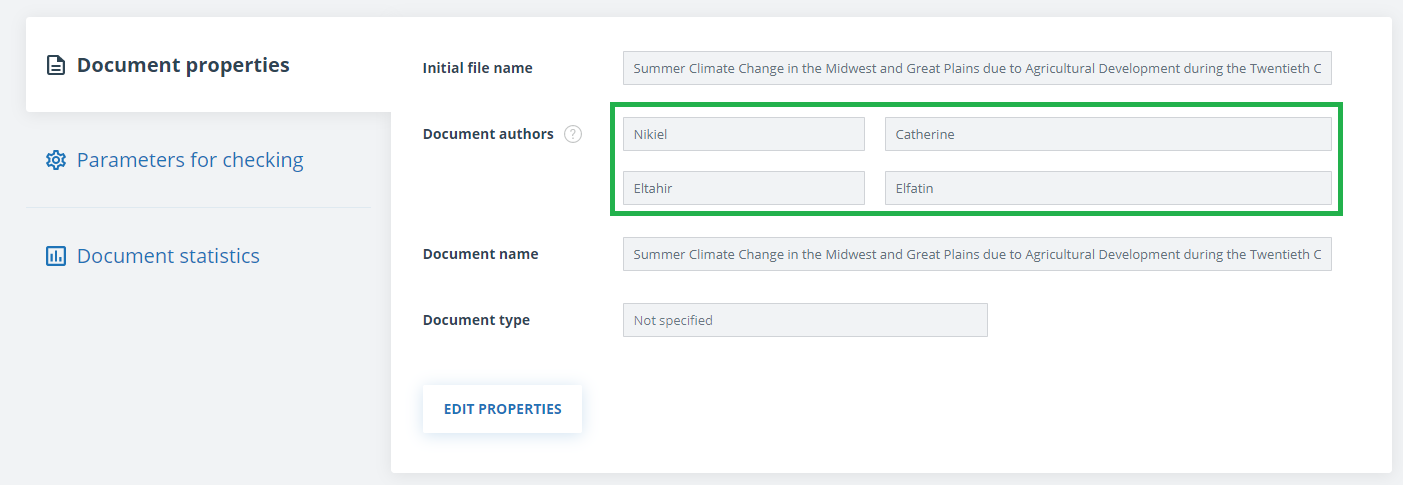
The system extracts up to 10 authors. The extracted authors are used to automatically calculate the indicator "Text recycling". Automatic calculation of the Text recycling percentage will be made within the eLIBRARY, RSL and NLB collections.
If the system has not extracted any author of the document, then in the document properties the "Document authors" fields will be highlighted in yellow. In this case, enter the author's name manually (see Manual adding the name of the document's author). The authors' names are required to calculate the indicator "Text recycling", and are also used to display information about the authors in verification certificate, printed and pdf-versions of reports.

Manual adding the name of the document's author
You may add the name of the document's author after checking the document. Сlick the "See results" button located next to the document and select "Edit properties". After that add the author of the document. You may add up to 10 co-authors.

After setting the author's name, the automatic process of text recycling percentage calculation will be started. You may correct the text recycling percentage manually by changing the types of sources.
Automatic calculation of the text recycling percentage will be made within the eLIBRARY, RSL and NLB collections.
Moving a document
To maintain the hierarchical structure of folders, use the "Folders" panel, displayed on the left in user Workspace. The "Folders" panel contains active items and buttons that allow you to perform actions on folders: add, delete (if the folder contains documents, they will be deleted), rename and move the folder, and navigate through the folders.
By default, a "Root folder" is automatically created in each Workspace, all other folders are created in it, this folder cannot be deleted, moved or renamed.
To the right of the folder names you will see a numeric value – this is the number of documents in the folder, so you can additionally control the distribution of documents by the folders.
To move a document from one folder to another, mark the document with a checkmark (you can select several documents to move), then click the "Move" button in the top panel.
The dialogue window will be opened; it will display the folder structure. Select the destination folder and click "Continue", then the document will move to the selected folder.

Document search
To search for a document, enter the full or partial name of the document in the search bar, and then click on the button in the form of a magnifying glass or the Enter key.

After the search is started, the list of documents will show the found documents in all the folders that are nested inside the root folder. You can navigate folders by leaving a request in action, then only documents on request will be visible in the folders.
Document deletion
To delete a document from the Workspace, tick it and click on the "Delete" button in the top panel.

If you are a corporate user, the document will be deleted from your Workspace, but will remain in the collection of the company with the mark "Deleted". The administrator of the company can restore the document deleted from the Workspace through the collection.
Reports' history viewing
When you recheck a document or edit a report, all previous versions of reports are saved in the system. To view the history of reports, select the document and click on the “Report History” button on the top panel.

You may see a brief information about all the reports created on this document in a separate opened window. Reports in a history are sorted in descending order of date.
To move to a detailed view or adjust one of the reports, click on the "Open" button. The report will open on a new page.
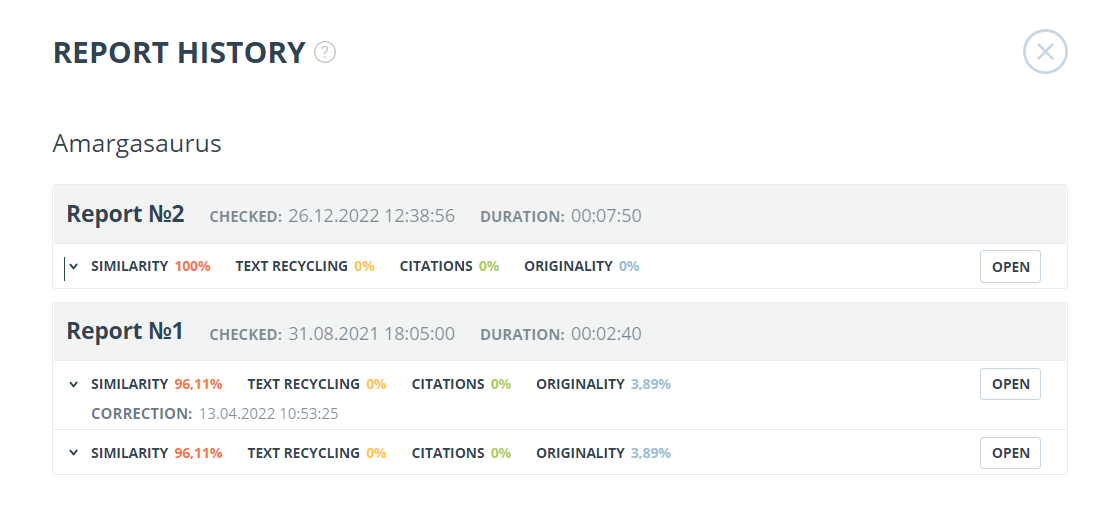
You may also see all the corrections of the report and edit the specific correction. A correction is created automatically after the report is edited.

Text metrics
On the check results page, on the "Text Metrics" tab, you can see various semantic characteristics of the document.
Please, pay attention that Metrics are calculated only for new documents. For documents uploaded before enabling this functionality, the calculation is not performed.
The block of text metrics is divided into the following components:
- Document rubrication
- Semantic characteristics
- Named entities
- Phrase segmentation
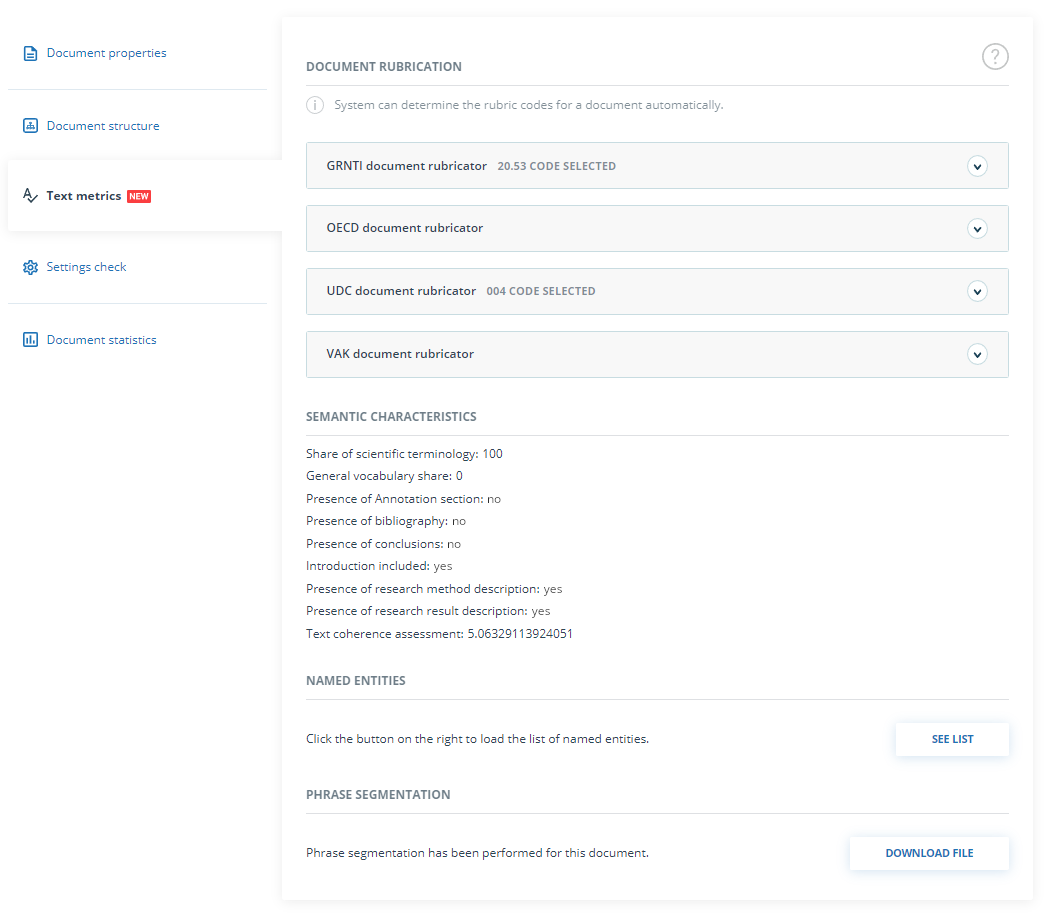
Editing document rubrication codes
After uploading the document to the system, you will be able to edit the codes of the categories of universal classifiers that allows you to attribute the work to a particular field of knowledge.
Automatically defined codes for each category are grouped into collapsed lists.. To expand and view the list, click on the button on the right side of the field with the name of the category.

To confirm one of the codes automatically determined by the system, click the "Confirm" button to the right of the desired name.
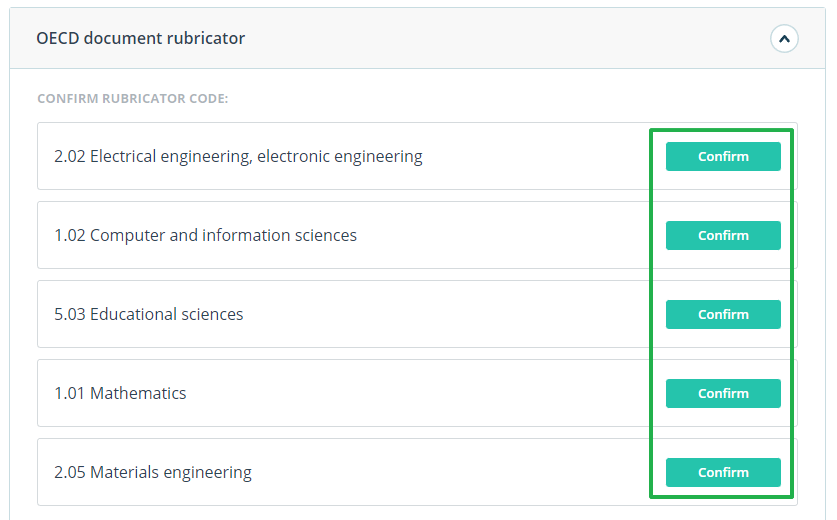
If no code has been determined automatically or there is no necessary code among the proposed codes, add it manually using the "Select from the full list" field at the bottom of the rubricator list. To do this, start by entering the name of the category.

To confirm the selection, click the "Add" button to the right of the selected code.

The selected code is displayed next to the name of the category. To reset and change the selected code, click the "Reset" button to the right of the name of the previously selected category.
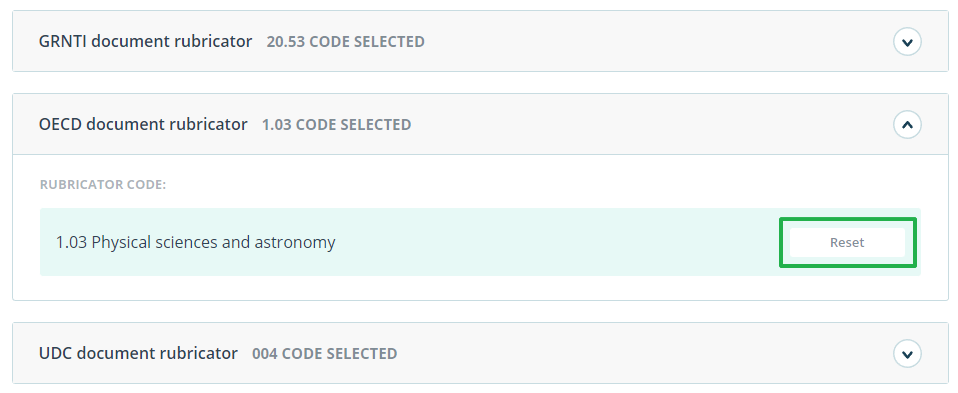
When the code is reset, you will be able to select the category again from the suggested list or specify it manually.
Semantic characteristics
The system calculates and displays of various semantic characteristics for each uploaded document. This functionality allows you to evaluate the scientific nature of the text, determine the presence of special sections in the document, and calculate some indicators. The calculation takes place automatically when the document is loaded.
List of calculated semantic characteristics:
- The share of scientific vocabulary. The indicator is from 0% to 100%, where 100% corresponds to a completely scientific text, and 0% corresponds to a completely unscientific text. The indicator is the ratio of words and phrases, included in «the dictionary of scientific terms and constructions»to the total number of words and phrases in the text being checked.
- The share of the general vocabulary. The indicator is from 0% to 100%. The formula used to calculate is (100% - [Share of scientific vocabulary]).
- The presence of an annotation.
- The presence of conclusions.
- The presence of an introduction.
- The presence of a research method description.
- The presence of a study results description.
- Assessment of the coherence of the text. The indicator is from 0% to 100%, where 100% corresponds to perfectly connected text, and 0% corresponds to completely disconnected text. The coherence of the text is characterized by the syntactic and semantic coherence of its sentences. When determining the coherence of the text, an error may occur due to the document being checked using OCR and the presence of images in the document being checked.

Named entities
To get a list of named entities, click the "View list" button in the "Named Entities" block.
A modal window opens, which displays a list of named entities as well as information about the number of named entities found in the document. Each named entity is located in a separate block.
For each named entity, entities are compared in various languages. To open a list with mapped entities, click on the arrow.
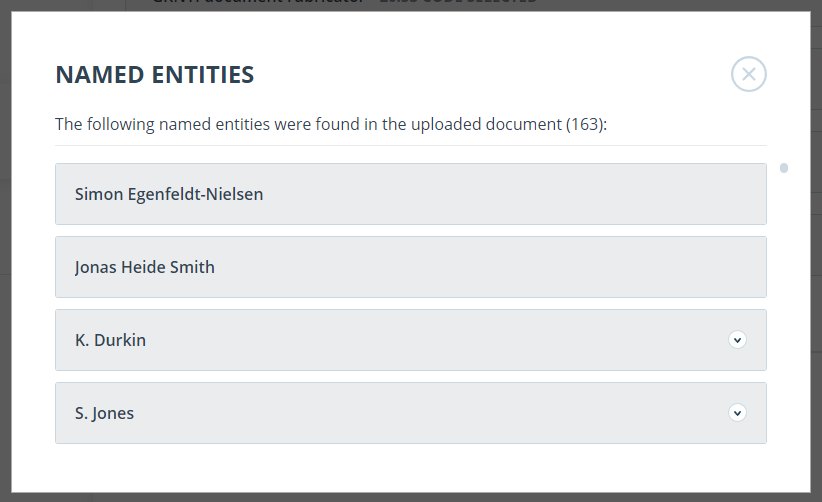
If an error occurs when forming a list with named entities, it will be displayed in the modal window.
Phrase segmentation
To view the list of segments and semantic units of the downloaded document, click on the "Download file" button. An XML file will be produced. Depending on your browser settings, the download will begin automatically, or a dialog box will open to allow you to download and save the file.
In the uploaded XML file, you will see your uploaded document presented as a list of segments. After the list of segments, a list of semantic units will be presented.
The report on the text reuse check result
Full report
After the document is loaded and checked, you may navigate to the report. To go to the full report view page, click the “See results” button located on the line with the checked document. After this click "Full report" button.

The full report includes:
- evaluation of originality / similarity / quotes / text recycling;
- evaluation of suspiciousness of a document with details on the "Suspicious document" page
- list of similarity sources with the ability to edit and go to the source report;
- continuous or page-by display of the full text of the document marked with the found similar blocks;
- page-by-page display of the full text of the document in the original document;
- the date of document checking;
- document's name;
- report correction.
The figure below shows a General view of the full report.
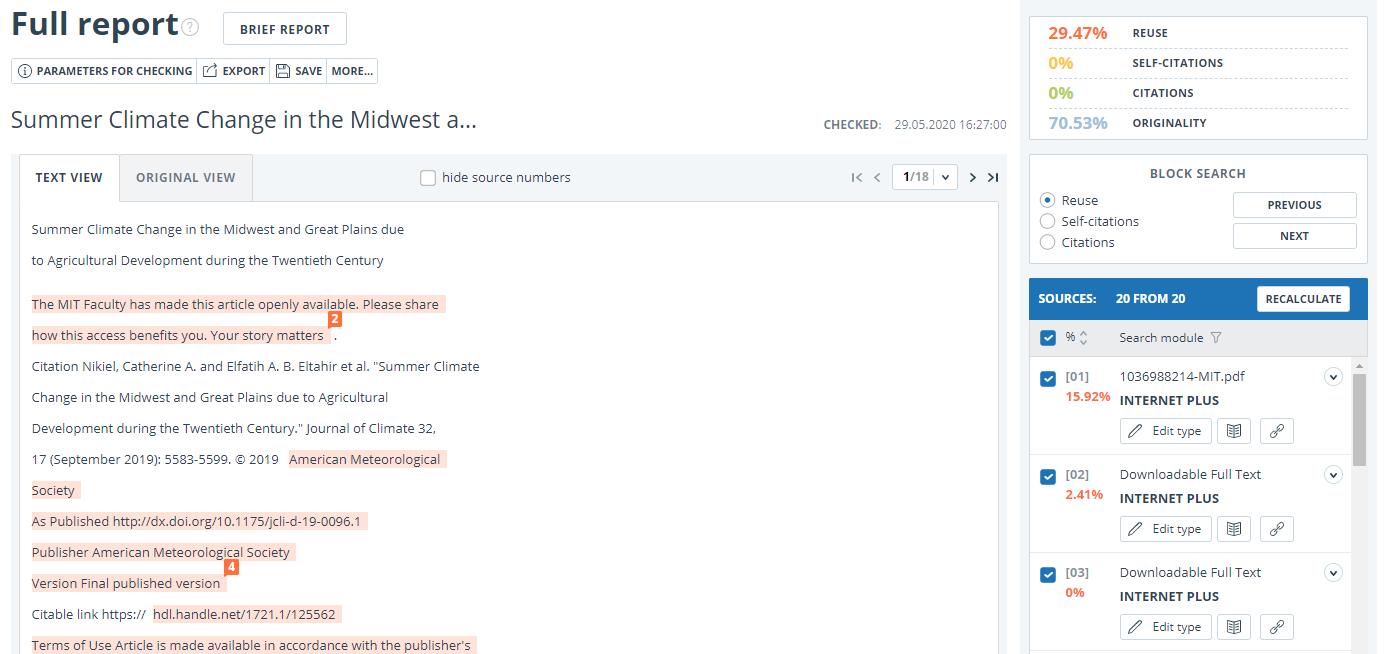
In the top panel of the page you will see the icon buttons, allowing you to proceed to the next action:
- parameters for checking;
- export of the report;
- save the edited report;
- link to user manual;
- view reports history;
- report printing layout;
- view text metrics;
- get a direct link to the report.
Viewing the report
The report page consists of the text to be checked, in which the similar blocks are highlighted, the list of sources, the aggregated results of the check and navigation through the blocks of similarity (search by blocks).
To navigate through the text pages, use the paging panel located above and below the text box. To display all pages of the document at once, click on "Show all pages" at the bottom of the document page.
To see which text fragments were similar and to which specific source, all text similar blocks in the system are highlighted, and at the end of each block there is a label with the respective number of the source.
When viewing similar blocks in a report, you can use block navigation (block search). With its help you can go to the next or previous block by pressing the "Previous" or "Next". You can also choose which type of text blocks to use.
Viewing information about the source
To view information about the source, find the source in the list, expand the respective source and click on the icon.

The source information window displays various data on the source: a link to the source, the date of its publication, the author, etc. The list of fields may be different depending on the search module and the source itself.
If the source is placed in index of approved by administrator of your company, then appropriate flag about the source appears. Text reuses from such source included in citing percentage and highlighted by green color.
Parameters such as text share, report blocks, text blocks are customizable. To do this, click on the "Menu", select the "Profile" section and go to the "Report settings" tab. You can choose which of the parameters will not be displayed in the report by unchecking one of them.

When analyzing sources, you can use both report share and text share. For a clear understanding of the difference between them, let's give an example: The report indicates two sources "Source A" and "Source B". According to the sources, the same paragraph of the text was found, which makes up 10% of the total volume of the document being checked. In this case, we will get the following data:
- Source A: text share is 10%, report share is 10%;
- Source B: text share is 10%, report share is 0% (because this text has already been taken into account from source A.)
Another way to view information about a source is to click on the source number in the full report text. A window will appear that contains basic information about the source.

External link to the source
For most sources in the list there is an external link to the location of the document or source text on the Internet. To go to the web page, click the icon next to the source name.
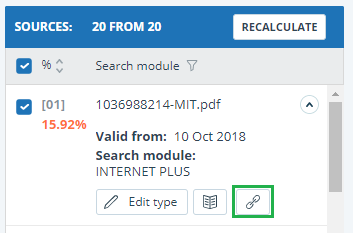
After clicking on the link, the web page on which the text of the block was found will be opened.
A situation may arise when the source is unavailable after clicking on the link. Perhaps the site administrators deleted the text, or the page "moved." But in any case, this text was available at the specified address when the site was added to the index of the search module of the system.
The fact that one or more of the report's links to the open sources on the Internet at the time of viewing the report do not work is not a reason to remove these links from the system's index. Texts at the links' addresses were indexed, before being deleted / moved, they were available to third parties, could be read, copied or otherwise used. Also, they could be stored in the cache of search engines and web archives, where they could still be found.
Viewing the source report
To view the source report, click the link in the source name in the list of sources. A new tab in the browser will open with the text of the source with which there was a duplication. Instead of text that doesn't overlap with the source, you'll see the number of characters that were skipped.
If you want to view the full source text, open the source link by clicking on the "Go to the source website" button.
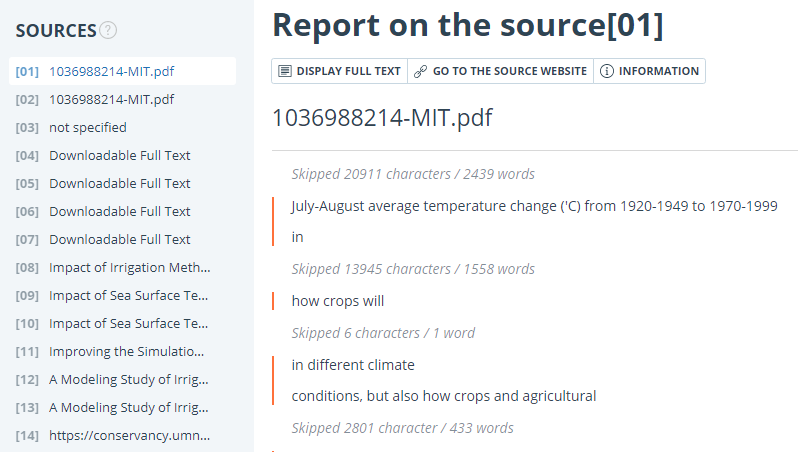
Click another source in the Sources pane on the left to view the report for that source immediately.
You can choose to view the report by source – page or solid text. By default, the source report is displayed page by page. To switch the view mode, click on "Show full text". When you switch to solid text view, the button changes to Show text page by page. Click it to go to page view.
Another way to view the source report is to go to the source report from the block in the text. Click on the source number at the end of the block, then click on the source name.
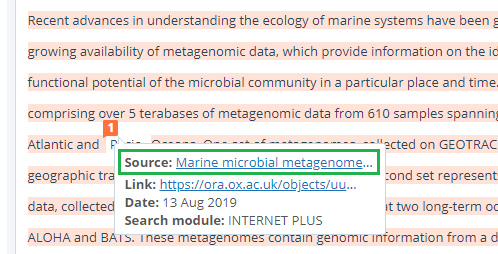
The page "Report on the source" will be opened with the selected block.
Viewing report history
When you recheck the document or edit the report, all previous versions of the reports are saved in the system. To view the report history, click the "More" button and select the "Report history" item in the top menu of the full report.
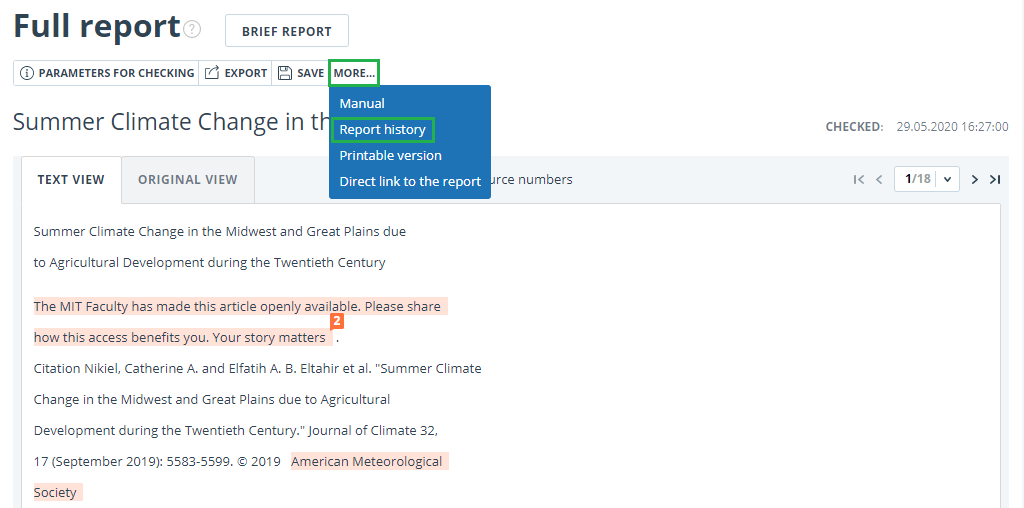
A separate window will open, where you will see a summary of all the reports made for this document. Reports in history are sorted in descending order by the build date.
To go to the detailed view or correction of one of the reports, click the "Open" button. The report opens on a new page.

You can also view all the corrections to the report, go to a specific correction and change it. The correction is created automatically when you edit the report.

Editing of the text blocks
You may adjust the check result not only by excluding or changing the source's type, but also by deactivating text blocks. This feature allows to not use the selected blocks when calculating the percentages.
To disable the necessary text block in the report, left-click on it. The “Deactivate” button will appear. After this the block will change color to gray. The system will automatically recalculate the percentages, but without accounting disabled text block.
To take the disabled text block into account again, find the disabled text block and click on it. The “Enable” button will appear. After clicking on it, the result will be recalculated again.
You may find out if there are the disabled text blocks and enable all the text blocks at once in the check results panel. To enable all text blocks, click on the “Enable All” button and the system will automatically recalculate the check result.
Also you may find out if there are any disabled text blocks in the workspace. In the list of documents a report that contains disabled text blocks has one more status : "The report contains disabled blocks".

Please note that text blocks of different sources may intersect with each other - one smaller block may be the part of the bigger block. After deactivating a large text block, the small text block will be deactivated with it.
You may use navigation on disabled blocks to the right of the report's text.
Comments to the report
On the full report page in the original view mode, you can make comments to the report. This functionality is not available in a text view mode. The comments button is located at the top panel of the page. The current number of comments to the report is shown in parentheses next to it. When you click on the button, a drop-down list of suggested actions opens. You can leave your comment and view all comments.

As you scroll down the document, the comments button moves to the right corner next to the page switching.

Adding a comment
When you click on "Create Comment", the mouse cursor changes to a special indicator of document areas where you can leave comments. In some areas of the document, the cursor may become translucent and colorless, which means you cannot leave comments on this area. A special mark is set at the place of the click, and a text box opens next to it. A comment length is limited to 250 characters.
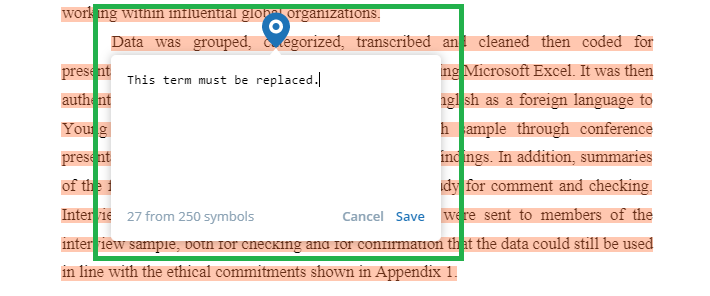
When you save a comment, a comment icon appears near the place where you made the mark.
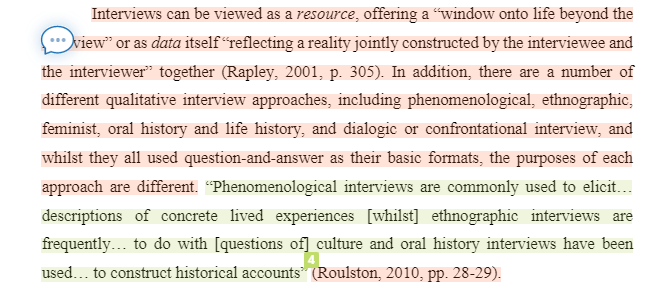
If you change your mind about creating a comment, you can click anywhere outside the comment, or click the "Cancel" button in the text box, and it will disappear. After that, the cursor will become standard. To re-comment, click the comment button at the top panel of the page again and select "Create Comment."
Actions with comments
Each user with the rights to comment can do the following:
- Viewing;
- Editing;
- Deleting.
You can edit your comments. To do this, click the "Edit" button, make changes and click the "Save" button. If you want to delete your comment, click the "Delete" button and confirm the deletion.
View all comments
To view all comments at the report, click on the comments button at the top panel and select the "View all comments" option in the drop-down list. You will see a modal window with a list of comment links. A comment link displays a full text of the comment in the report. Viewed links are highlighted in grey.
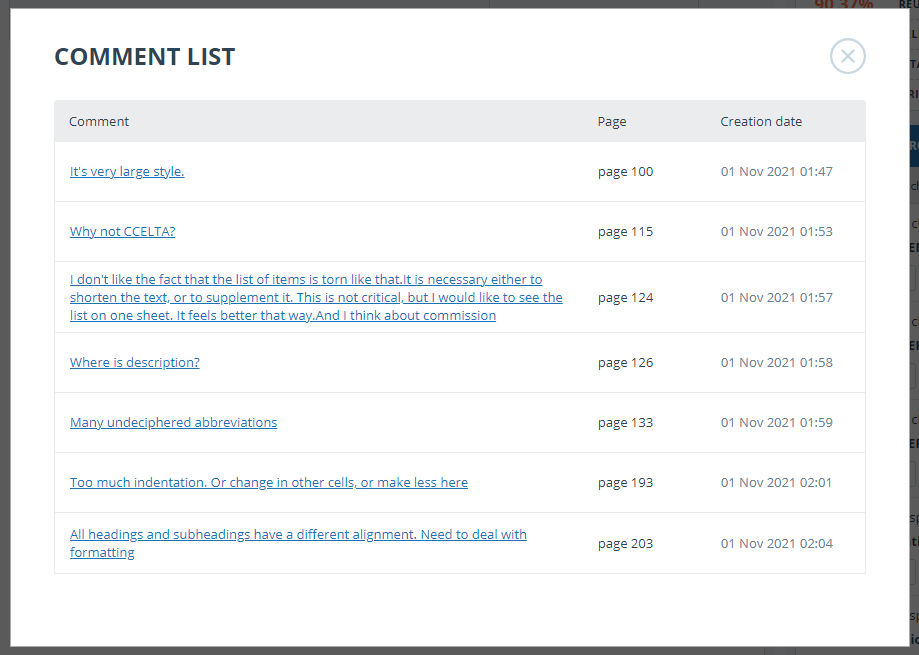
You can click on the comment text only. After the click, the modal window with the comments list will close, a page with the comment will display and a textbox with the comment will open on the page.
Access by a direct link
A direct link to a report displays all comments in a read-only mode. You cannot create and edit comments even if you are logged in to the system.
Brief report
To go to the brief report view page, click the “See results” button located on the line with the checked document. After this select "Brief report" button.
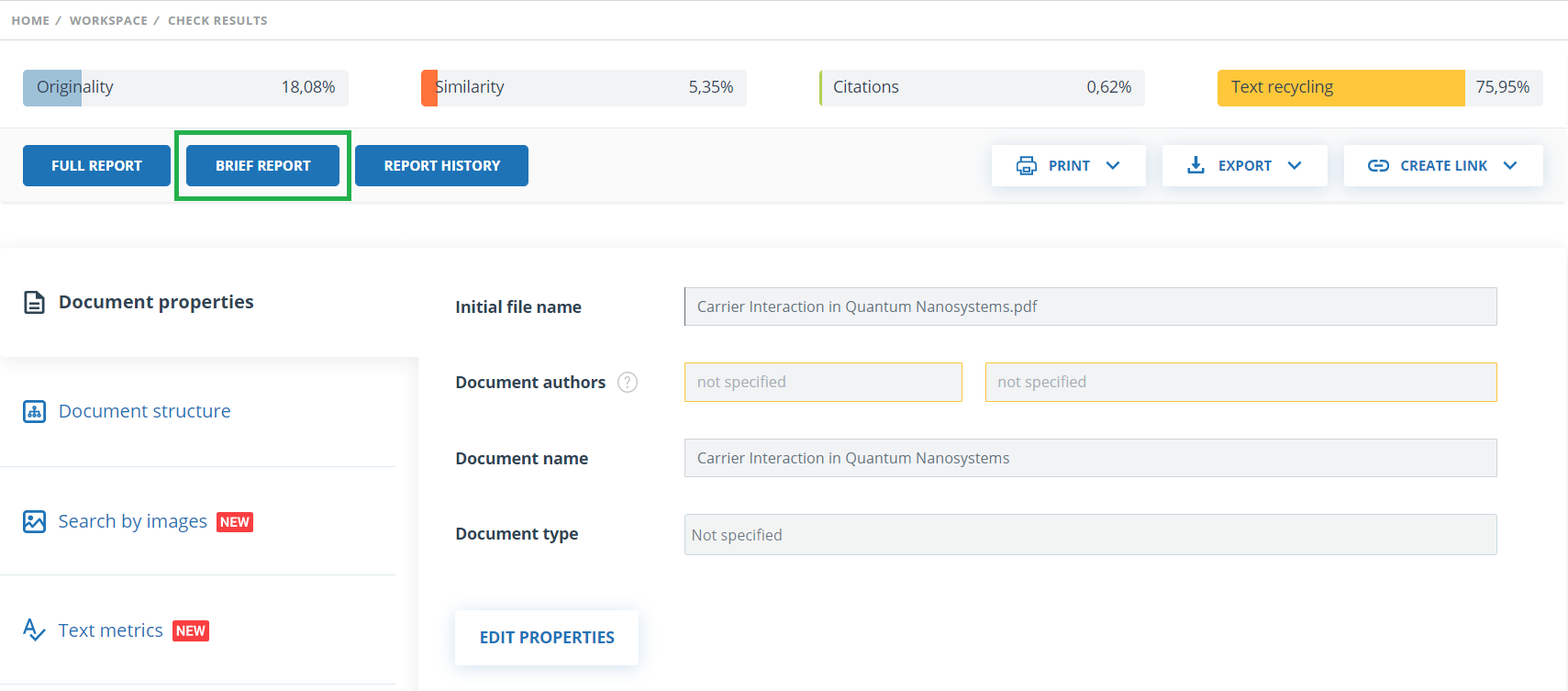
Brief report consists of distribution of percentages of originality, text similarity, quotes and text recycling as well as a list of similarity sources.

For most sources in the list there is an external link to the location of the document or source text on the Internet. To go to the web page, click the icon next to the source name.

In the top panel of the page you will see the icon buttons, allowing you to proceed to the following actions:
- parameters for checking;
- export of the report;
- save the edited report;
- link to user manual;
- view reports history;
- report printing layout;
- view text metrics;
- get a direct link to the report.
To get more information about the results of the check, open the full report by clicking on the "Report" button.
Report with formatting
A formatted report allows you to view the results of the document check while maintaining the original formatting (indentation, fonts, titles) and displaying tables and figures.
To view the report with the formatting, switch the tab "Text view" to the tab "Original view".
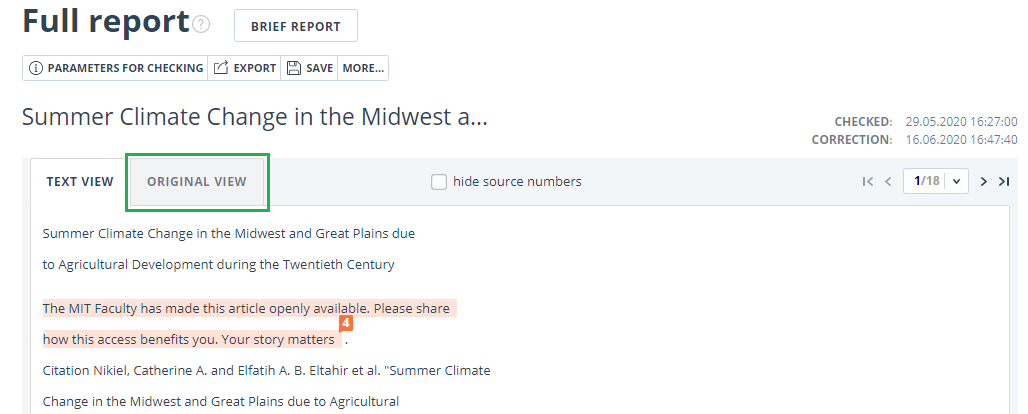
The Original view tab, as well as the Text view tab, displays reused parts and a list of sources, but the markup is applied to the original formatting of the document.
It is worth noting that when you export the pdf report, the text of the document is downloaded without any formatting.
You can view the document in its original form in the "Version for reading". To do this, click on the name of the document in your account. The text view of the document opens, then click the "Original view" tab.
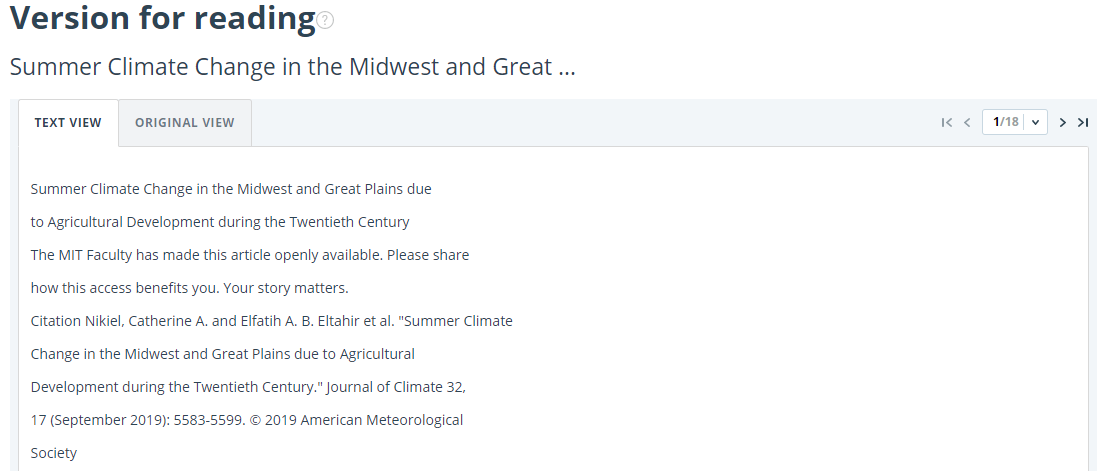
Please note that when adding for check files in txt, htm, html, pptx format, direct text input, you cannot view the original formatting of the document.
Document Structure
You can find sections of the checked document on the check results page in the "Document Structure" tab. The structure is extracted automatically while document is being checked for similarity.
Here you can see information about the following sections:
- Title page;
- Content;
- Main part;
- Bibliography;
- Appendix.

The following information is provided for each section:
- Whether it has been included in the check or not;
- The number of pages in the section;
- Page numbers for each section;
- Section’s text share compared to the text of the entire document
If a section has not been found by the system, a special notification will be displayed.
The block on the left shows a diagram of the document structure. Each section is marked in its own color. The sequence of the sections on the diagram reflects the sequence of the sections in the document.
When you click on the "Document Structure" button, a detailed analysis of the document divided by structure opens in a new tab.
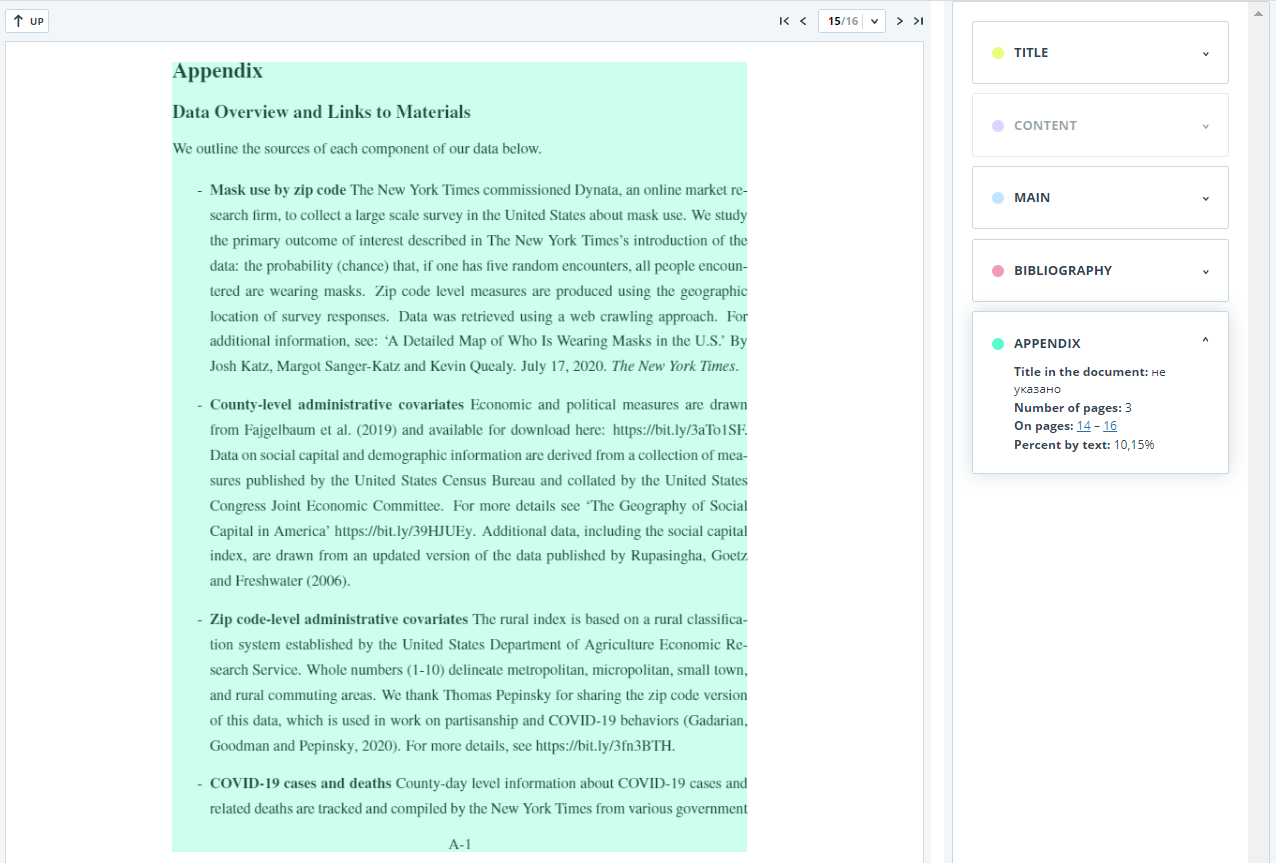
The panel on the right contains blocks with the sections. When you click on the block, you can see the information on the particular section. Clicking on the page number takes you to the respective page of the document. The text in the document is highlighted by the color of the corresponding section.
On this page you can edit the structure of the document recognized by the system if you see any errors. The following actions are available to you:
- adding a section;
- changing the borders of a section;
- deleting a section.
Adding a section
To add a new section that was not recognized by the system automatically, you need to open the menu for the desired section and click the "Add section" button.

After clicking this button, you will need to put markers for the beginning and end of the section being added. The start marker appears first. It should be placed on the first line of the section in any place. After setting the start marker, you need to put the end marker on the last line of the section in the same place. If everything is put down correctly, click "Apply" to complete the markup of the section.

Changing the section borders
You can edit the borders of an existing section. To do this, click on the "Change borders" button near the beginning or end of the section. Then you can left-click on the marker that you want to move. With the next mouse click, you can set the marker to a new position. When you are satisfied with the changed section borders, click "Apply" to complete the editing.

Deleting a section
You can also delete a section if it was identified incorrectly and needs to be removed. To do this, click the "Delete section" button at the beginning or end of the section. Please note that you cannot delete the "Main part" section, since it is mandatory.

Saving changes and refreshing check results
After making changes to the structure of the document, they need to be saved. To do this, click the "Save" button at the top of the screen.

Please pay your attention that after saving the changes in the structure, they are not automatically applied to the report. In order to see the results of checking the document with the updated structure, you need to recheck the document. For more information, see Document recheck
Suspicious document
A suspicious document is a document that shows signs of technical ways to change the text or format, such as replacing characters, inserting invisible text, etc. Such signs may indicate that the author tried to cheat the system to hide text reuses and artificially increase the originality percentage. If such signs of cheating have been found in the document, a special flag will be put for it in the workspace and the list of documents of the company.

Please note that if you see a suspicious flag, we recommend that you carefully read the check report and the suspicious fragments found in the document. Detection of suspicious documents is an auxiliary tool for analysis. The final decision is always up to the verifier.
The information that the document shows signs of a cheating is displayed in the check reports, in the printable versions, and in the downloaded reports. In a brief report the page numbers with the detected potential cheating attempts are displayed.
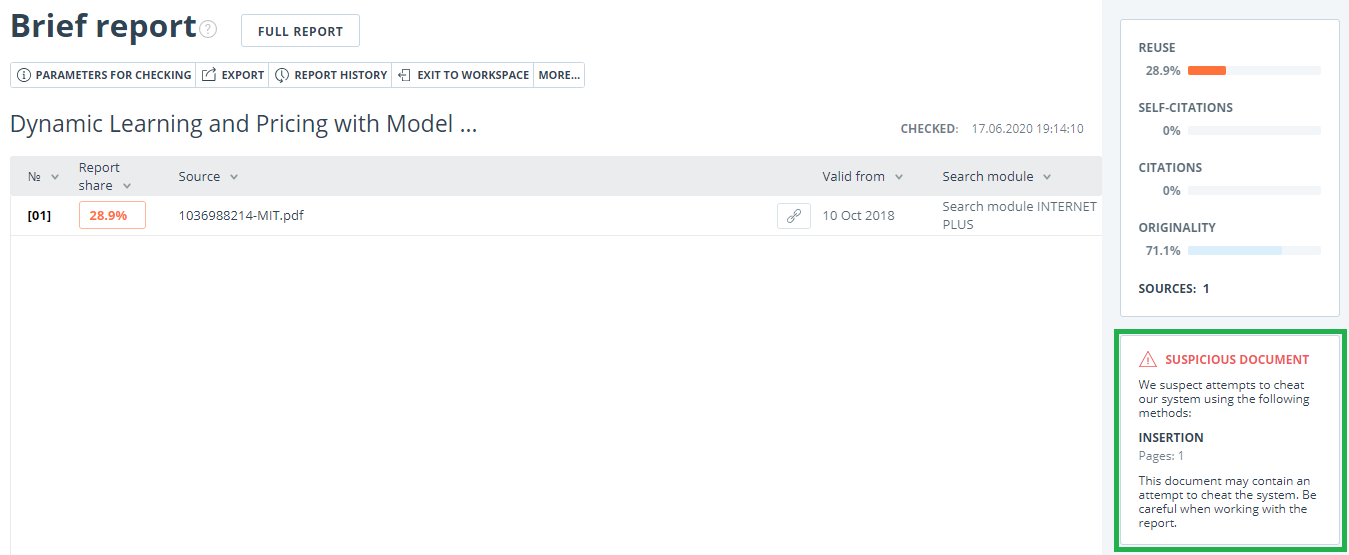
The printable version of the check report provides information about potential cheating attempts. It shows the types of cheating and page numbers where suspicious fragments have been found. Similarly, information is displayed in the downloaded versions of reports.
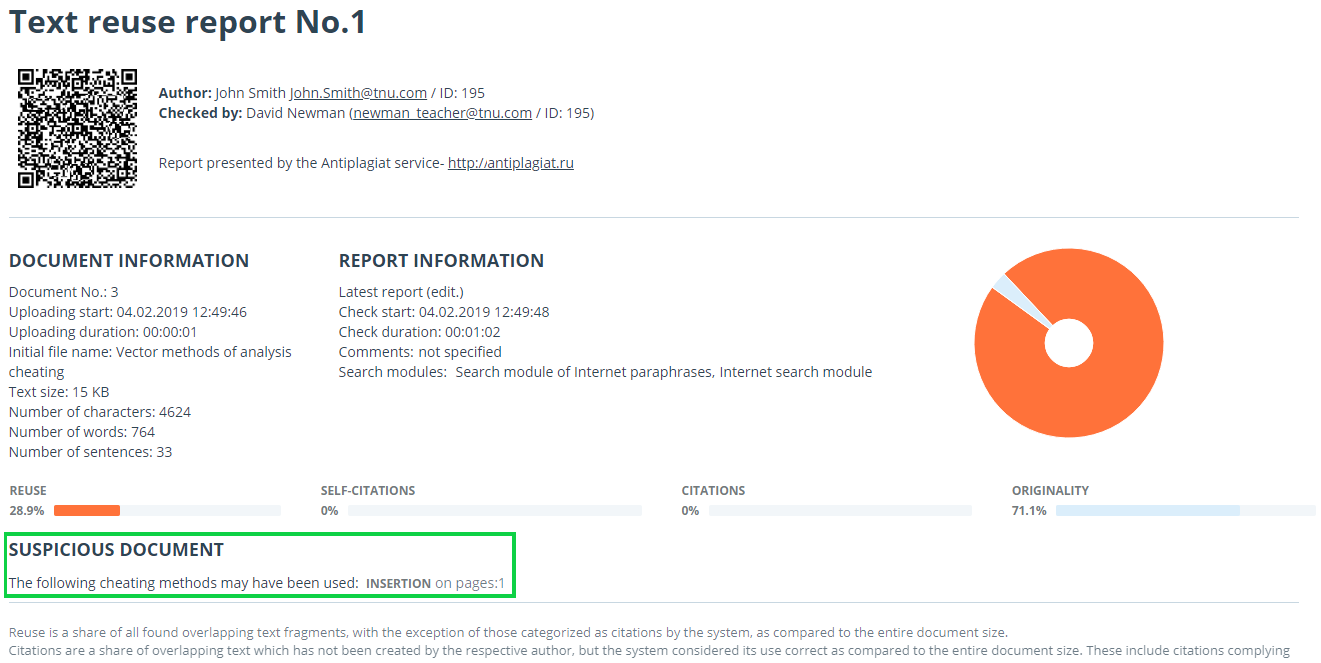
A special block with a suspicious mark is displayed in the full report for a suspicious document. Click "View" to go to the "Suspicious document" page and view detailed information about the suspicious text fragments. If the loaded document does not have formatting, instead of transferring to the "Suspicious document" page, the system will display page numbers with potential attempts to cheating the system.

Please note that if the uploaded document has no formatting, then instead of the link to "Suspicious document" there are the page numbers with potential cheating attempts displayed in the full report.
You may also access information about possible cheating on the “See Results” page. To do this, click on the "Details" link in the red suspicious document warning block.

The "Suspicious document" page displays detailed information about the suspicious fragments found in the document. You can read the text of the document in the form in which it was uploaded into the system (keeping the original formatting). If a fragment is found on the document page that may containg cheating attempt, it is marked in red.
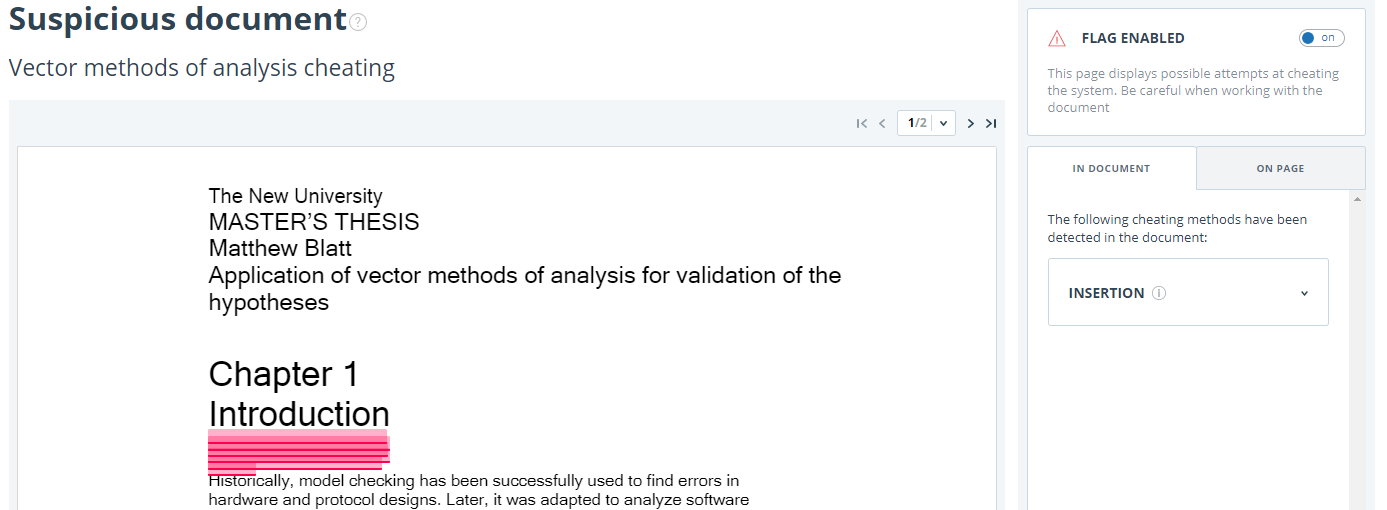
To view information about suspicious fragments for the entire document, click the "In document" tab in the right panel. To view the page numbers, click the name of the cheating method. To go to any of the listed pages, click on the desired number.

The "On page" tab provides information about suspicious fragments on the selected page of the document. To display certain cheating methods, check them and uncheck the others. The selected cheating methods are highlighted in red on the page, the removed cheating methods are underlined with a red line. To select all suspicious fragments on the document page at once, click on "Display all". In order to remove the selection from all the suspicious fragments, click on "Hide all".
It is also possible to review the text of the cheating, if it was extracted during the document processing.

If the document does not contain cheating, you can disable the "Suspicious document" flag. To disable the flag, use the enable/disable button in the upper right corner of the "Suspicious document" page. You can leave a comment explaining why you disabled the "Suspicious document" flag. If you view the "Suspicious document" page through a direct link, you will not be able to disable the "Suspicious document" flag.
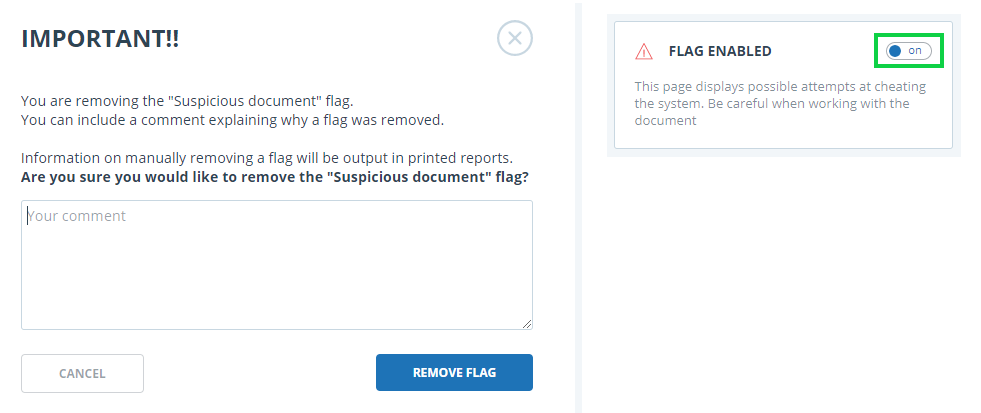
If you disable the "Suspicious document" flag:
- the respective icon will not be displayed in the Workspace;
- the brief report will not display information about the cheating;
- in the downloaded forms of reports and in a printable versions the information will appear in the "Suspicious document" section that the flag was disabled, and comments will be displayed;
- in the full report, you will see that the "Suspicious document" flag has been removed – the corresponding icon will become gray;
- you still have access to the "Suspicious document" page.

Downloading the report
Downloading the report will allow you to save the report as a PDF file. To download the report to your computer, click on the "Export" button on the report viewing page.

Page will appear "Export report". To start the report generation, click on the "Export" button. After some time, the button will change to "Download". Click on the "Download" button to download the file. The download will start automatically, or the file download and save dialogue window will open, depending on your browser settings.
In the downloaded report you will see information about the report and the loaded document, a terminological block with the description of the terms "Similarity", "Quotes", "Originality", "Text recycling", a list of sources and text with markup of quotation blocks (if the user unloads the full report).
Direct link to report from "See results" page
A direct link to the report allows you to give access to the report to any user, including users unauthorized in the system. This link allows you to view the report, however you cannot make changes to the report.
To get a direct link to a report, select the document in the workspace and click the “See results” button. After this click on "Create link" button and select "To full report" or "To brief report" in the drop-down list. A link to the selected type of report will be copied in the clipboard.

Also you may get a direct link to a report from "Full report" or "Brief report" pages. For example, to get a direct link to a full report, open the "Full report" page and click "More" in the top menu, then click the "Direct link to the report" button. A link to the full report will be copied in the clipboard.
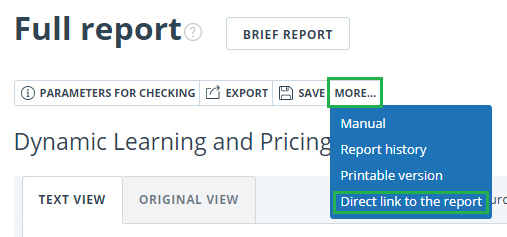
The mechanism for obtaining a direct link to a short report is the same as to a full report.
An external user who has followed a direct link will be able to view the report and text metrics (if this function is enabled), print the report to a page, and export the report (if this function is enabled). You cannot edit a report using a direct link.
The user can also share a link to a recheck report or a report with corrections. To do this, in the report history, open the version of the report or adjustment you are interested in. After that, perform the steps described above.
Purchase of services in the workspace
The service provides rate plan and free access plan. The free access provides the service with the limited features of the workspace. With the free access you have a possibility to carry out checks on the reuses, using the Internet free search module and view only the brief reports. In rate plan, the functionality is close to the corporate systems "Antiplagiat.Edu", "Antiplagiat.Expert" and others. Rate plan supports access to the full report and check by an extended set of search modules.
To get access to the full functionality of the service and the maximum quality of checks, connect Full rate plan. Full rate plan contains the "Unified collection" - a universal module that provides a search for reuse both in open sources of the scientific and educational Internet segment, and in the private collections of the "Antiplagiat" company partners. "Unified collection" includes all available search modules and additional services.
The possibilities of rate plan and its difference from the free plan are shown on the "Rate plans" page.

Purchase of checks
To purchase checks, click on the "Buy checks" button on the rate plans page.
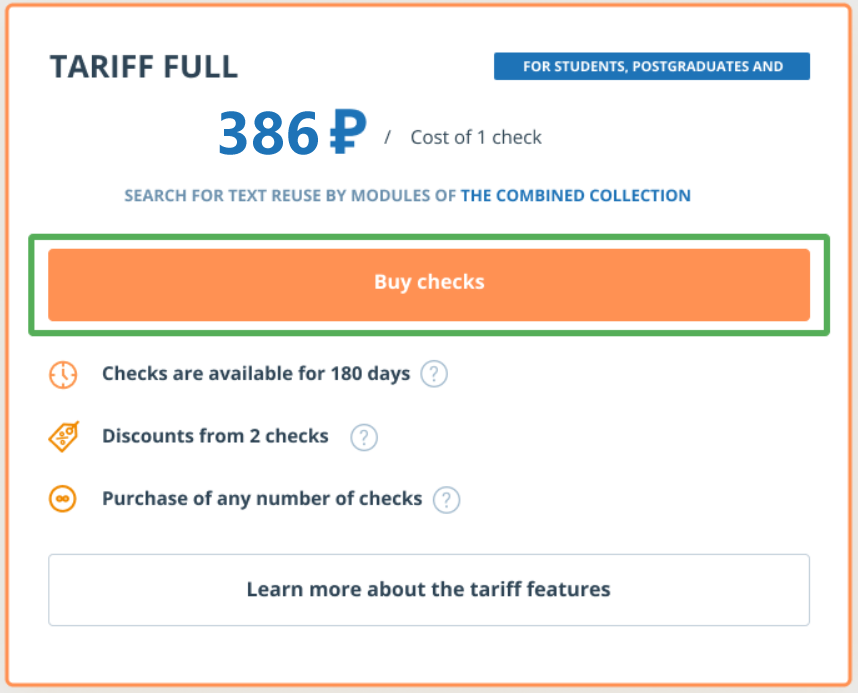
After that, checks purchase page will be displayed.

Select the required number of checks. The more checks, the cheaper the cost of one check. Specify the payment method, click on the "Go to payment" button and follow instructions of the payment service. If you have points, you can spend them when paying for checks by checking the box "Use points for payment". Checks will be activated automatically after receipt of funds. If you pay in full with points, the checks will be activated immediately after clicking on the "Go to payment" button. The validity period of the checks begins immediately after activation, and lasts 180 days. In the "header" of the site you will see type of your current rate plan, total number of checks for all rate plans and time counter before the expiration of the checks.
You can get more detailed information about the purchased checks on "Statistics" page.
"Statistics" page
On the "Statistics" page you can view detailed information about the purchased services in your workspace. To go to the page of activated services' statistics, click on the "Menu" icon in the upper right corner and select the "Statistics" item. The "Statistics on added services" page will open. At the top of the page you will see the brief information about the current rate plan, number of checks and remaining points.
Below is a table with detailed information about your checks and activated search modules. The table has two tabs - current and used services. The tab "Current services" displays "Information about checks" and "Added search modules".
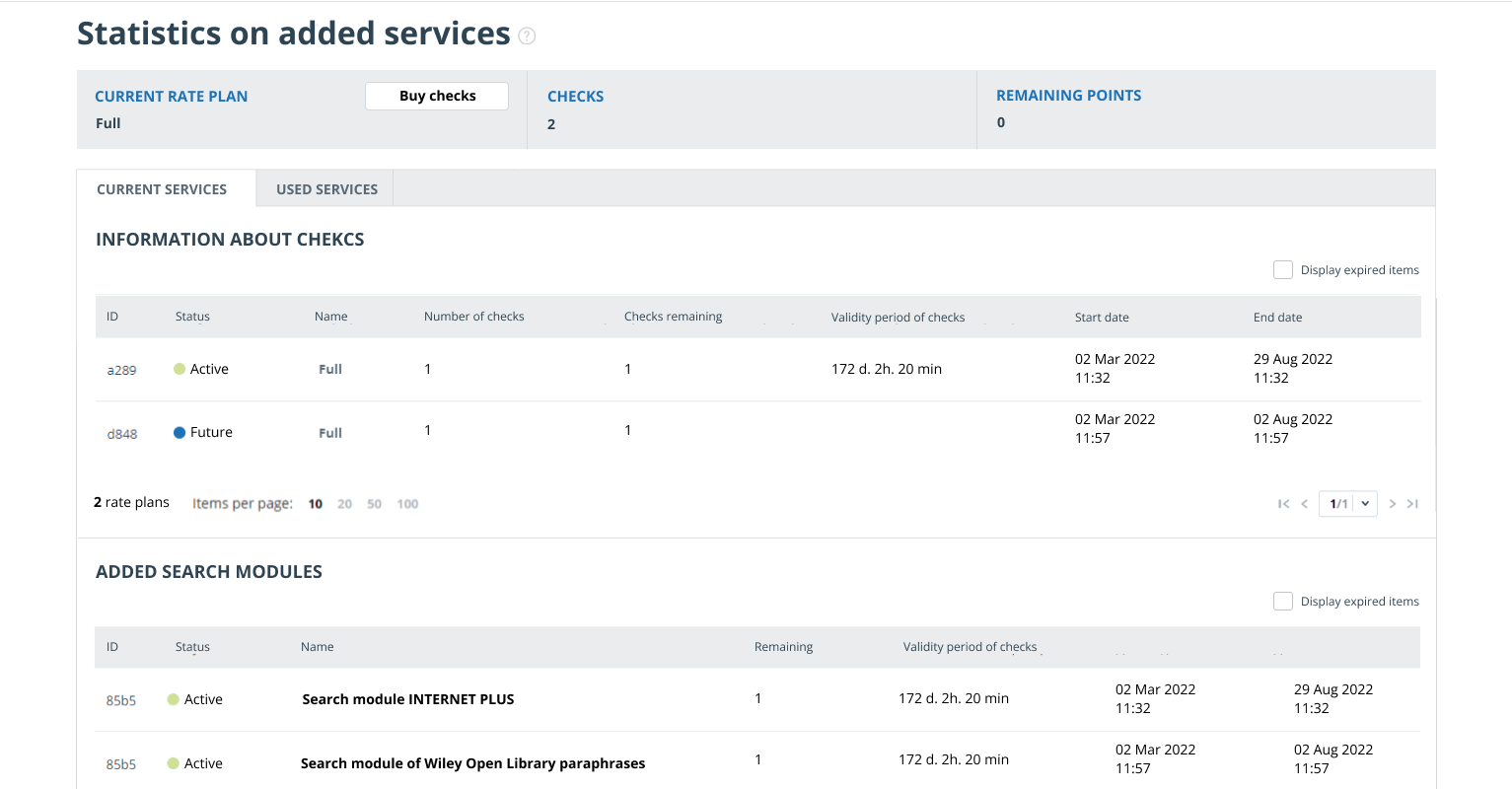
In the "Information about chekcs" table, you can view information about purchased checks. Rate plan from which checks will be deducted at the moment is displayed with the status "Active". Rate plans with the "Future" status are rate plans that will consistently switch to the "Active" status after the end of the current rate plan. By clicking on "Show expired connections", you will see the expired rate plans.
To view the history of used services, open the "Used services" tab. The upper part of the tab provides filtering of the list of services by date of use. To apply the filter, specify the desired date range and click "Apply". To cancel the action of the received filter, click on the cross.
“Balance” page
You can view the history of completed operations with your personal account in the workspace on the "Balance" page. To go to the "Balance" page, click on the "Menu" icon, and then select the "Balance" menu item. On this page there is a table with a list of purchases of checks.

If there are a lot of operations, which have been made in your workspace, you might want to use the filter of operations. By default, the list of operations is sorted by operation's date in descending order. You can change the order of sort in the header of the table, and the direction of the arrow will change, pointing to the sorting method, and the column, which is currently sorted, is highlighted in bold.